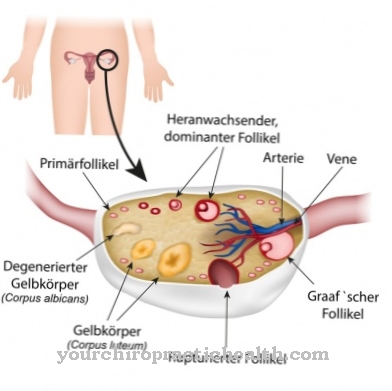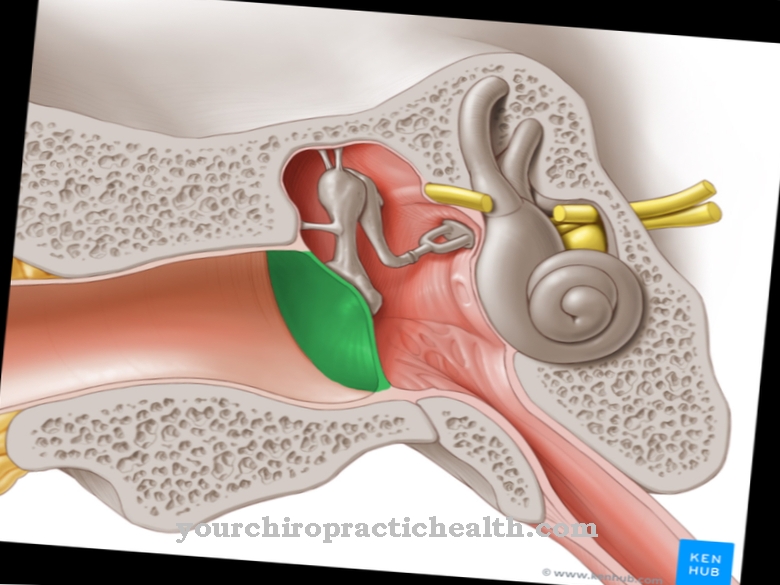The uterus (technical language: uterus) is an organ in the female pelvis. It serves as a fruit holder in the event of pregnancy. In addition, the uterus influences the woman's sexual perception and her hormonal balance.
What is the womb?

The uterus is a muscular hollow organ that is approximately the size and shape of an upside-down pear. Outside of pregnancy, it measures 7-9 cm in length and approx. 5 cm in width. Their weight varies between 30 and 120 g.
The uterus is one of the internal sexual organs of women. It lies outside the peritoneum (extraperitoneally) between the bladder and rectum. The uterus is held in position by a holding apparatus made up of various ligaments and the muscular pelvic floor.
Normally, the uterus is slightly inclined forwards in relation to the vagina (anteversion) and bent forward (anteflexion).
Anatomy & structure
At the uterus Different anatomical sections are distinguished: The upper end is called the uterine fundus (fundus uteri) - here one fallopian tube opens on each side. The body of the uterus (corpus uteri) joins at the bottom. This finally narrows to the uterine isthmus (isthmus uteri) and to the cervix (cervix uteri).
As the lower end of the uterus, the cervix (portio vaginalis uteri) protrudes into the vaginal vault. The wall of the uterus has a three-layer structure: the outer perimetrium is covered by peritoneum. The middle and thickest layer, the myometrium, consists of smooth muscles.
Inside is the endometrium, a layer of the mucous membrane that is subject to strong hormonal changes. The mucous membrane at the exit of the uterus is very different from the mucous membrane in its main body.
Functions & tasks
Primarily serves the uterus as a fruit holder in case of pregnancy. In women of childbearing potential, the lining of the uterus prepares itself in each menstrual cycle to accept a fertilized egg.
If fertilization does not take place, the superfluous parts of the mucous membrane in the menstrual period are rejected again. If, on the other hand, a fertilized egg is implanted, the endometrium, controlled by hormones, continues to grow and store nutrients so that the uterus can house and feed the growing embryo. The uterus can grow 20 to 30 times its normal size during pregnancy.
This enormous magnification is made possible by their special spiral-shaped muscle fibers. During the birth process, the strong muscles of the uterus also drive the child out. Meanwhile, medicine knows that the uterus is not only important in the context of pregnancy, but also for a woman's sex life. Contractions of the uterus play a role in the female ability to orgasm.
In addition, the cervical mucus plays a role in moisturizing the vagina.Patients who have had their uterus removed often experience sexual dysfunction as well as depression and an earlier onset of menopause. Hence, it is believed that the uterus also affects the production of hormones by the ovaries.
Diseases
Diseases of the uterus are called metropathies. A well-known disease is cervical cancer (cervical cancer). Cervical cancer is the second most common malignant tumor in women globally and is often caused by human papillomavirus (HPV) infection.
The routinely performed Pap test during gynecological preventive examinations is used for early detection, the HPV vaccination for the prevention of cervical cancer. Tumors also often develop in the lining of the uterus. These are known as endometrial cancer and occur in Germany about twice as often as cervical cancer. The first symptom is spotting or flesh-colored discharge.
Growths of the uterine muscles (fibroids) are very common, but usually benign. In addition to tumor diseases, there are various congenital uterine malformations. These go back to the fact that the uterus arises embryonic from the fusion of two so-called Müller ducts. If this amalgamation does not take place or only partially, anomalies arise that also affect fertility.
In older women, the uterus often sags due to weakness in the pelvic floor. In extreme cases, the uterus can prolapse (uterine prolapse). Removal of the uterus (hysterectomy) is performed very often in Germany: It is the second most common operation in 40 to 49-year-old women and accounts for around 50% of all gynecological operations performed.
Typical & common diseases
- Uterine inflammation
- Fibroid (uterine tumor)
- cervical cancer
- Uterine cancer (endometrial cancer)



























